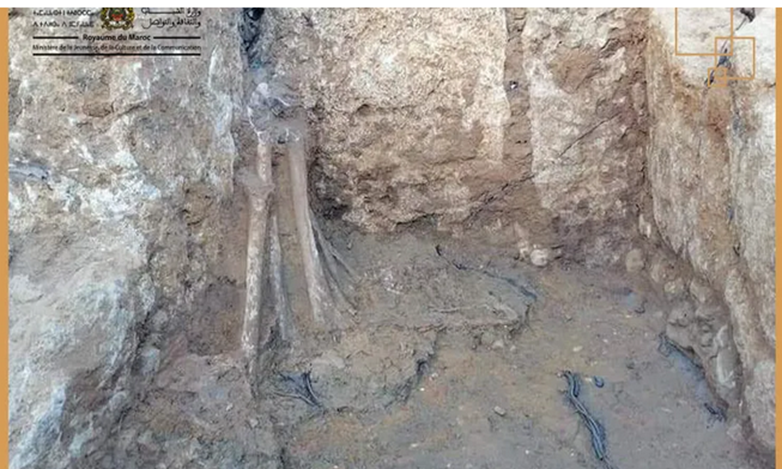Morocco: The discovery of the burial place of a prominent figure in the Moorish-Amazigh era, dating back more than 2,000 years

The ruins of the ancient city of Lixus, north of the sea port of Larache in Morocco, on April 10, 2013 AFP PHOTO/FADEL SENNA
“We carried out emergency rescue excavations with scientific excavations, and fortunately the interior of the grave was untouched, and we identified the internal structure and personal belongings with it, which was an iron knife blade.”
The National Institute of Archeology and Heritage in Morocco reported the discovery of “the remains of an ancient burial ground dating back to the Moorish-Berber era preceding the Roman occupation, dating back more than 2,000 years” in the Larache region (northwest of Morocco). This discovery would “contribute to enriching our knowledge of funerary practices and beliefs.” The religious faith that was widespread within the village community in the Locos Basin region during the Mauryan era, extending from the eighth century BC to the year 40 AD.

According to the same source, it is expected that laboratory analyzes will be conducted on the remains of the body using “Carbon 14,” “to provide an accurate dating of the bones,” which will bring closer to “resuming research to find out the rituals of the rural area during the Moorish period, the presence of whose inhabitants is documented by written sources.”
The discovery process was led by Moroccan archaeologists Abdelaziz Al-Khayari and Ammar Akraz, and a professor at the Institute of Archeology and Heritage Sciences, Abdelaziz Al-Khayari, said, “What took place at the site were rescue or emergency excavations, because they were not programmed. The Institute intervened to rescue and document, because the site was threatened, which is what It was monitored by the Prefecture of the Lixos Archaeological Site. Al-Khayari added, in a statement to the Moroccan news website Hespress, that “the funerary mounds in northern Morocco differ from other mounds. They are like large mounds, which can range between twenty to thirty meters, and their height ranges between one and three meters.” meters, and this pile extends for more than twenty meters, and is approximately three meters high, and similar ones have previously been found in the area.”

The remains of an ancient burial ground dating back to the Moorish era prior to the Roman occupation, dated to more than 2,000 years ago in Morocco Ministry of Youth, Culture and Communication in Morocco
The archaeologist pointed out, “We intervened because the owner of the land began construction work on a house, and the mound appeared to him as a problem, and he did not realize that it was a burial ground, because it was made of dirt. The mound was bulldozed, and when he reached the grave, he removed its cover, but the Lixus Governorate in the area intervened and stopped the work. I informed the Institute of Antiquities, which intervened immediately," and he continued, "We carried out emergency rescue excavations with scientific excavation, and fortunately the interior of the grave was untouched, and we identified the internal structure and personal belongings with it, which are an iron knife blade, and a unique axe made of the same metal that is of special importance.” He said, “These mounds require a lot of labor, and unlike similar cemeteries, this is built, and the stones with which it is covered for protection are cut and sanded, and brought from a far place, often from the coast, because the type of stone used is not found in the place, and this great care means that the buried person has “It has an important legal value. We assume that he is the head of the Morey tribe, because he is present in the rural area.”

The photo shows the ruins of the ancient city of Lixus, north of the sea port of Larache in Morocco. FADEL SENNA / AFP
In the context, Al-Khayari stopped at the “Moorish civilization,” saying: “The local Moorish community belongs to the ancient Amazigh groups in North Africa, and the Moorish kingdom and civilization are well-known. They are Amazighs, of course, prior to the Roman invasion.” He explained that “the dead person’s bones are not complete, and the traces on them indicate that they were partially burned, which is an ancient ritual.” We do not know the belief behind this yet, as this is an archaeological ritual linked to beliefs and not arbitrary, and it is found in other cemeteries in the direction of the Grand Palace that have funerary mounds spaced in the rural area.”
Regarding the importance of the site, Al-Khayari stated that it provides researchers with “information about the funerary rituals of burying the dead and dealing with them locally,” adding: “This is neither a Phoenician nor a Carthaginian ritual. It is a different ritual from the rituals of the Phoenicians and Romans, who completely cremated the body, while placing the remains in Utensils, and burial on the back. The tomb shows a ritual specific to the Moors that predated the Roman presence. We do not yet know what religious rituals are hidden behind it.”
Source : websites

